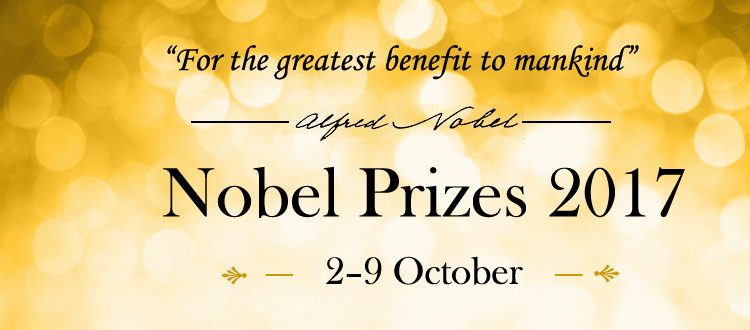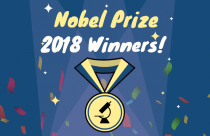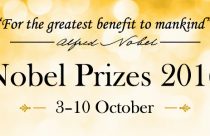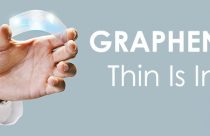2017 Nobel Prizes: An Insight Into the Winners and Their Accomplishments

The Nobel Prize is the most prestigious award given in recognition of academic, cultural, and/or scientific advances. The Nobel prizes in Chemistry, Literature, Peace, Physics, and Physiology or Medicine were first awarded in 1901. Continuing the age-old tradition, this year too, starting 3 October, a select group of scientists will be in the spotlight for tireless work and dedication in their fields.
Here is a quick checklist on all the facts about the Nobel Prize.
What Does “Nobel Laureate” Mean?
The word “laureate” refers to being signified by the laurel wreath. In ancient Greece, laurel wreaths were awarded to victors as a sign of honor. In layman terms, a Laureate is a person or organization nominated for significant achievement in a particular field, and a Nobel Laureate is someone who has been awarded the Nobel Prize.
Who Nominates and Selects the Nobel Prize Winners?
According to Alfred Nobel’s last will and testament in 1895 and an amendment in 1969, the following institutions are responsible for selecting the Nobel Laureates: The Royal Swedish Academy of Sciences for the Nobel Prize in Physics, Chemistry, and Economic Sciences; The Nobel Assembly at Karolinska Institutet for the Nobel Prize in Physiology or Medicine; The Swedish Academy for the Nobel Prize in Literature; and The Norwegian Nobel Committee for the Nobel Peace Prize.
You can read more about the nomination and selection process here.
Did You Know?
- The Nobel nomination processes begin in the month of September every year.
- Self-nomination for Nobel Prizes is not permitted.
- The names of the nominees cannot be publicly disclosed until 50 years have passed!
- 911 Nobel Laureates so far!—885 individuals and 26 organizations have been awarded the Nobel Prize between 1901 and 2016. Of them, 78 are Laureates in Economic Sciences.
- Nobel Prizes have not been awarded in some years and most of these instances occurred during World Wars I (1914–1918) and II (1939–1945).
- The most common fields for Nobel prize winners in Physics is particle physics, in Chemistry it is biochemistry, in Medicine it is genetics, in Economic Sciences it is macroeconomics, and in Literature it is prose.
- 49 Women have been awarded the Nobel Prize and Prize in Economic Sciences between 1901 and 2016.
- Jean-Paul Sartre and Le Duc Tho were the only two Nobel Laureates who declined the prize.
- The United States has produced the highest number of Nobel Laureates so far (Harvard University is the world leader in this category).
- The Nobel Prize amount has increased from 8 million Swedish kronor (SEK) in 2016 to 9 million Swedish kronor (SEK) or approximately USD 1.1 million in 2017.
You can read more such interesting facts here.
Can Nobel Winners be Predicted?
Among all the speculations for the Nobel honors, Thomson Reuter’s Citation Laureates has been releasing its annual prediction report using citation data from its Web of Science platform to identify highly influential researchers. Of these Citation Laureates, 39 individuals have actually gone on to win a Nobel prize. This count includes the winners of the 2014 and 2015 awards in Physics and Economics—Arthur B McDonald, Angus S. Deaton, Shuji Nakamura, and Jean Tirole.
The Lasker Award, widely considered as the United States’ most coveted recognition for biomedical research (and also called the US-equivalent of the Nobel Prize in Physiology or Medicine), can be used to predict Nobel Prize winners in this category to some extent. So far, eighty-seven Lasker Award winners have also been awarded a Nobel Prize in Physiology or Medicine.
2017 Announcement Dates*
| Category | Dates of announcement |
| Physiology or Medicine | Monday, 2 October |
| Physics | Tuesday, 3 October |
| Chemistry | Wednesday, 4 October |
| Literature | Thursday, 5 October |
| Peace | Friday, 6 October |
| Economic Sciences | Monday, 9 October |
*Announcements will happen between 11:00 am and 1:00 pm, Swedish Time.
2017 Nobel Prize Awardees
- Physiology or Medicine: The 2017 Nobel Prize in Physiology or Medicine went to Jeffrey C. Hall, Michael Rosbash and Michael W. Young of the USA for their discoveries of molecular mechanisms controlling the circadian rhythm, i.e., an internal biological clock that anticipates day/night cycles to optimize the physiology and behavior of organisms. The Nobel Foundation shared the following about their research:
This year’s Nobel Laureates, who were also studying fruit flies, aimed to discover how the clock actually works. In 1984, Jeffrey Hall and Michael Rosbash, working in close collaboration at Brandeis University in Boston, and Michael Young at the Rockefeller University in New York, succeeded in isolating the period gene. Jeffrey Hall and Michael Rosbash then went on to discover that PER, the protein encoded by period, accumulated during the night and was degraded during the day. Thus, PER protein levels oscillate over a 24-hour cycle, in synchrony with the circadian rhythm.
We now know that all multicellular organisms, including humans, utilize a similar mechanism to control circadian rhythms. A large proportion of our genes are regulated by the biological clock and, consequently, a carefully calibrated circadian rhythm adapts our physiology to the different phases of the day.
- Physics: The 2017 Nobel Prize in Physics went to Rainer Weiss, Barry C. Barish and Kip S. Thorne for their decisive contributions to the LIGO detector and the observation of gravitational waves. A century ago, Albert Einstein predicted the existence of gravitational waves in his general theory of relativity. The Nobel Foundation shared the following about their research:
The 2017 Nobel Laureates have, with their enthusiasm and determination, each been invaluable to the success of LIGO. Gravitational waves spread at the speed of light, filling the universe. They are always created when a mass accelerates, like when an ice-skater pirouettes or a pair of black holes rotate around each other. Einstein was convinced it would never be possible to measure them. The LIGO project’s achievement was using a pair of gigantic laser interferometers to measure a change thousands of times smaller than an atomic nucleus, as the gravitational wave passed the Earth.
- Chemistry: The 2017 Nobel Prize in Chemistry went to Jacques Dubochet, Joachim Frank and Richard Henderson for developing cryo-electron microscopy for the high-resolution structure determination of biomolecules in solution. This new microscopy technique simplifies and improves the imaging of biomolecules. The Nobel Foundation shared the following about their research:
Biochemical maps have long been filled with blank spaces because the available technology has had difficulty generating images of much of life’s molecular machinery. Cryo-electron microscopy changes all of this. Researchers can now freeze biomolecules mid-movement and visualise processes they have never previously seen, which is decisive for both the basic understanding of life’s chemistry and for the development of pharmaceuticals.
In 1990, Richard Henderson succeeded in using an electron microscope to generate a three-dimensional image of a protein at atomic resolution. This breakthrough proved the technology’s potential. Between 1975 and 1986, Joachim Frank developed an image processing method in which the electron microscope’s fuzzy two-dimensional images are analysed and merged to reveal a sharp three-dimensional structure.
Jacques Dubochet added water to electron microscopy. Liquid water evaporates in the electron microscope’s vacuum, which makes the biomolecules collapse. In the early 1980s, Dubochet succeeded in vitrifying water – he cooled water so rapidly that it solidified in its liquid form around a biological sample, allowing the biomolecules to retain their natural shape even in a vacuum.
- Literature: The Swedish Academy has decided to award the Nobel Prize in Literature to Kazuo Ishiguro who, in novels of great emotional force, has uncovered the abyss beneath our illusory sense of connection with the world. The permanent secretary of The Swedish Academy mentioned the following:
If you mix Jane Austen and Franz Kafka then you have Kazuo Ishiguro in a nutshell but you have to add a little bit of Marcel Proust into the mix, and then you stir but not too much. At the same time, he’s a writer of great integrity. He’s developed an aesthetic universe all on his own. All his books are wonderful and truly exquisite. I would say that my favorite is The Buried Giant. I also love The Remains of the Day. I think its a true masterpiece. He is someone who is very interested in understanding the past. He is not out to redeem the past, he is exploring what you have to forget in order to survive in the first place as an individual or as a society.
- Peace: The 2017 Nobel Peace Prize went to the International Campaign to Abolish Nuclear Weapons (ICAN) for its work to draw attention to the catastrophic humanitarian consequences of any use of nuclear weapons and for its ground-breaking efforts to achieve a treaty-based prohibition of such weapons. The Norwegian Nobel Committee shared the following:
Nuclear weapons pose a constant threat to humanity and all life on earth. Through binding international agreements, the international community has previously adopted prohibitions against land mines, cluster munitions and biological and chemical weapons. Nuclear weapons are even more destructive, but have not yet been made the object of a similar international legal prohibition.
Through its work, ICAN has helped to fill this legal gap. An important argument in the rationale for prohibiting nuclear weapons is the unacceptable human suffering that a nuclear war will cause. ICAN is a coalition of non-governmental organizations from around 100 different countries around the globe. The coalition has been a driving force in prevailing upon the world’s nations to pledge to cooperate with all relevant stakeholders in efforts to stigmatise, prohibit and eliminate nuclear weapons. To date, 108 states have made such a commitment, known as the Humanitarian Pledge. ICAN has been the leading civil society actor in the endeavour to achieve a prohibition of nuclear weapons under international law. On 7 July 2017, 122 of the UN member states acceded to the Treaty on the Prohibition of Nuclear Weapons. As soon as the treaty has been ratified by 50 states, the ban on nuclear weapons will enter into force and will be binding under international law for all the countries that are party to the treaty.
This year’s Peace Prize is therefore also a call upon these states to initiate serious negotiations with a view to the gradual, balanced and carefully monitored elimination of the almost 15,000 nuclear weapons in the world. With this year’s award, the Norwegian Nobel Committee wishes to pay tribute to ICAN for giving new momentum to the efforts to achieve this goal. The decision to award the Nobel Peace Prize for 2017 to the International Campaign to Abolish Nuclear Weapons has a solid grounding in Alfred Nobel’s will. ICAN works vigorously to achieve nuclear disarmament. ICAN and a majority of UN member states have contributed to fraternity between nations by supporting the Humanitarian Pledge. ICAN has played a major part in bringing about what in our day and age is equivalent to an international peace congress.
- Economics: The Royal Swedish Academy of Sciences has decided to award the Sveriges Riksbank Prize in Economic Sciences in Memory of Alfred Nobel 2017 to Richard H. Thaler for his contributions to behavioural economics. He has incorporated psychologically realistic assumptions into analyses of economic decision-making. By exploring the consequences of limited rationality, social preferences, and lack of self-control, he has shown how these human traits systematically affect individual decisions as well as market outcomes. The committee mentioned the following about their contribution:
This year’s Laureate Richard Thaler played a crucial role in the development of behavioral economics over the past four decades. He provided both conceptual and empirical foundations for the field. By incorporating new insights from human psychology into economic analysis, he has provided economists with a richer set of analytical and experimental tools for understanding and predicting human behavior. This work has had a significant cumulative impact on the economics profession; it inspired a large number of researchers to develop formal theories and empirical tests, which helped turn a somewhat controversial, fringe field into a mainstream area of contemporary economic research.
A first contribution by Thaler is his pioneering work on how deviations from ideally rational behavior systematically shape economic decisions. In Thaler (1980), he coined the term endowment effect for the tendency of individuals to value items more just because they own them, and showed how this phenomenon relates to loss aversion in prospect theory (Kahneman and Tversky 1979). A second contribution relates to self-control problems that prevent agents from carrying out their optimal plans, even if they can compute them. In the planner-doer model of Thaler and Shefrin (1981), an individual is assumed to be both a myopic doer, who evaluates options only for their current utility, and a farsighted planner, who is concerned with lifetime utility. A third contribution by Thaler is to show how social preferences are essential for economic decision-making. He also showed how concerns for fairness affect the behavior of individuals in consumer and labor markets, with important implications for optimal firm behavior.
The Nobel Prize in Economic Sciences concludes the series of Nobel Prize announcements. These awards will now be presented on 10 December, the 121st anniversary of prize founder Alfred Nobel’s 1896 death.
- Announcement of Nobel Prize in Physiology or Medicine
- Announcement of Nobel Prize in Physics
- Announcement of the Nobel Prize in Chemistry
- Announcement of the Nobel Prize in Literature
- Announcement of the Nobel Peace Prize
- Announcement of the Nobel Prize in Economic Sciences










Amazing that the world was so tired of what we had to offer, and my guess is it was the exact time for this to guy to come along and create a special event and show the world because it was about to lose it soul and heart. Perfect planning is the key to everything but hard work and giving back more than you came is what will help you go to sleep and into the dirt, with happiness and enlightened will guarantee truly happy to return attitude and supported future opportunities for the next generation.